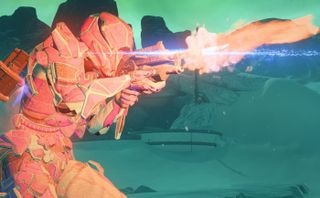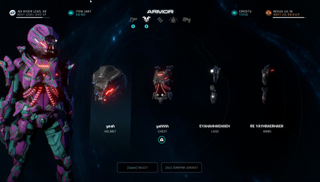How to make the best weapons and armor in Mass Effect: Andromeda
We explain Research and Development, how to get resources quickly, and what items to prioritize for your playstyle.

Mass Effect: Andromeda’s menus are their own game, taking the form of a traditional folder hierarchy, burying types and subtypes of armor, weapons, and modifications beneath layers of garish UI. But beneath it all, the Research and Development system hides a playful, deep weapon and armor customization system. It just takes some time and patience to wrap your head around the thing.
We’re here to help with that. In this guide, we break down the R&D system and point you in the right direction, so none of those precious resources go to waste.
Making sense of R&D
Research and Development is made more complex than necessary through some messy menus, but even then, there’s a lot of gear to invest in. For someone just getting started who doesn’t know how often research comes in or what character spec they’re going to pursue, it’s overwhelming. A few things to keep in mind if you’re stressed:
Experiment! You’ll find more than enough research points to build what you want.
Researching items you don’t end up liking doesn’t force you into a corner.
Don’t be afraid to favor fashion over function—Andromeda never gets so difficult that you have to min-max.
Simply put: R&D is a convoluted store for armor and weapons. Let’s break it down.
The biggest gaming news, reviews and hardware deals
Keep up to date with the most important stories and the best deals, as picked by the PC Gamer team.
Research
You purchase escalating tiers of blueprints in the Research section using Research Data, obtained by whipping out that annoying scanner and clicking on red things. Keep in mind that by spending Research Data (RD) on the blueprints you’re not purchasing the item itself. Doing so makes it appear in the Development menu, where you can spend resources to craft items. That said, researching blueprints also gives that item a chance of appearing in the world on corpses and in containers. You read that right: technology doesn't exist in the universe until you've seen a picture of it on your space computer.
How to get Research Points
Spend AVP on upgrades that give you materials or increase your research gains. In general, you should prioritize spending Andromeda Viability Points on anything that gives you resources at timed intervals. Free stuff is free stuff, and doesn’t require you to sit through the boring galaxy map flight sequences time and time again.
Look for anomalies as you travel. You don’t need to scour every planet in every system for resources. That’s a waste of time. But anomalies tend to hide satellites or unique objects that give you a handful of research points.
Scan everything you can. I don’t like the scanner either, but whip it out in any new room and you’ll likely find some kind of technology to click on. Doing so is the most efficient way to get research points since the entire game world is littered with the stuff.
Buying blueprints
Those nonsensical glyphs at the top of the Research menu represent the Milky Way, Heleus, and Remnant branches of technology. The differences between research branches aren’t just aesthetic either. Each camp’s armor and weapons have differences in attributes and behavior.
Milky Way weapons are the most vanilla of the bunch, looking and behaving most like their real life counterparts. They’re good all-around weapons, capable of decent damage with fairly predictable behaviors. Don’t expect wild trigger pull behaviors or mechanical skill ceilings you haven’t already practiced in every other shooter already. Choose this branch if you’re looking for a familiar, snug fit.
Heleus weapons are based on Kett technology and pack the biggest punch of all the branches. That punch comes with a caveat though. The Dhan is a powerful ‘shotgun’ that fires a single pellet in an arc. It’s hard to track and get a good feel for, but once you do, it’ll take out the toughest enemies in a few hits. The Isharay sniper rifle does over 1000 damage per hit, but with a low clip size and slow rate of fire, you better not miss. Choose this branch for the most high-skill weapons of the bunch.
Remnant weapons are all erratic energy weapons that don’t use ammo, but can overheat if fired continuously for too long (remember Mass Effect 1?). They don’t have much in the way of damage, but their rate of fire and cooldowns are faster than most weapons. Choose this branch if you don’t want to stop shooting for long, but only if you don’t mind prolonging each encounter.
Armor selections between each branch only echo their weapon selection in looks. Otherwise, they don’t define playstyles as distinctly as weapons, granting small buffs to support whatever you’d like a boost in: damage resistance, power regeneration, shield strength, and so on. Take my advice and pick whatever makes you look best.
Augmentations between branches also don’t matter as much. They’re fairly cheap overall, with more powerful 200 RD augs rounding out each branch. I recommend researching them all whenever you have a few hundred points to spare (and you will). They’ll make your guns so much cooler.
What to research first
Research weapon augmentations willy-nilly—they’re fun to experiment with once you get deeper into the R&D system. For instance, you can build a shotgun with reflective pellets that stun enemies or a sniper rifle that shoots plasma rounds you can charge up. Again, armor gives small enough buffs that you can choose based on where you think you need a boost most, or as I recommend, purely on what makes your butt look good. Weapons are more discrete though. If you need a bit more direction, here are a few suggestions based on preferred playstyles. If you want to know where to allocate skill points, check out our character build guide.
For aggressive, in-your-face assault players focused on DPS before crowd management and teamplay, go with the Milky Way’s Ruzad shotgun, but nearly any shotgun will do.
If you like to hang back and snipe or coordinate biotic powers with team members, keeping the enemies’ position in full view, then go with Heleus’ Isharay. Its high precision and damage makes quick work of most enemies. If you’re into precision, but want a bit more in terms of crowd control, try out the Naladen, also in the Heleus branch. Its projectiles explode and damage anyone in the vicinity.
Maybe you’re more about versatility. Go with the Dhan shotgun. It’s surprisingly effective at close- to mid-range since it fires a single, arcing pellet. It’s not exactly a hall-of-famer in PC shotguns, but it still does a ton of damage. I used it for most of the endgame, which turned the combat scenarios into a cakewalk. SMGs work too, if you’re not confident in your accuracy with Dhan’s crossbow-like behavior.
Development and gathering resources
Your best items will come from development, but it can require wrangling a few mods, augmentations, and a ton of minerals to make them stand out.

If you research something, that item and variations of it are more likely to appear in the field, meaning you’ll find them on dead enemies and in crates. That’s total permission to research whatever you can early on. The more items researched means there’s a higher chance for finding something better while you’re out adventuring. And the greater your surplus of good armor and weapons, the better you’ll fare in combat—and have a ton of junk to deconstruct into extra resources for more targeted R&D. There’s little penalty to researching whatever you want early on since the higher tiers are locked behind level 20 and 30 requirements. If you don’t know what you want, research whatever strikes your fancy. Fashion always comes before function.
Once you’ve researched something, go play the game. Some of the planets have enemy outpost scenarios where you tear through dozens of enemies and take on a boss at the end. They also have a ton of containers hiding rarer loot drops. With so many dead bad guys dropping loot as well, it’s a great way to stock up on new gear and get variations of blueprint items you’ve just researched. Otherwise, play as normal and your new stuff will drop eventually.
Deconstruct old items. You’ll run across more than enough if you’re playing naturally. Inventory space runs out quickly anyway, so taking apart old items is a given and they’re not stingy with the resource return.
Check on strike teams every time you return to the Tempest. Over time, Strike Teams are the easiest way to get money, resources, and research. Deploy them on missions with 50% or more success rates and buy new teams as soon as you can. The more teams out, the more resources you’ll accrue over time. There’s even an app to manage your teams on the go, if you’re desperate.
Buy what you need if it’s available. Don’t worry about spending money. If you’re doing any side missions or spending time in the open worlds, you’ll be swimming in the stuff. Use the ‘Sell All Scrap’ button every time you visit a vendor.
From here on, it’s just a matter of assembling your weapons and armor and giving them cool names. Throw in whatever augmentations you’ve research for buffs in areas you’re looking for an edge in, pop in mods once the item is assembled if there’s room, tweak the colors on your new armor, and roll out into the Heleus cluster with some newfound confidence. You’ll be turning heads everywhere you go, either by looking fly or literally turning them inside out with your shiny new exploration assistants: guns.
James is stuck in an endless loop, playing the Dark Souls games on repeat until Elden Ring and Silksong set him free. He's a truffle pig for indie horror and weird FPS games too, seeking out games that actively hurt to play. Otherwise he's wandering Austin, identifying mushrooms and doodling grackles.
Most Popular


